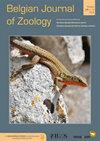The genus Charcotia Chevreux, 1906 in the Southern Ocean, with the description of a new species (Crustacea, Amphipoda, Lysianassoidea).
IF 1.1
4区 生物学
Q2 ZOOLOGY
引用次数: 4
Abstract
It is demonstrated here that Charcotia Chevreux, 1906 (Amphipoda) has priority over Charcotia Vayssiere, 1906 (Gastropoda), and that Waldeckia Chevreux, 1906 has to be treated as an invalid objective junior synonym of Charcotia Chevreux, 1906. An analysis of a part of the mitochondrial COI gene of Charcotia indicates that Charcotia obesa sensu lato, consists of two genetically distant clades that fulfil the criteria of genetic species. Each genetic clade corresponds to a different morphotype. The first one has a low triangular protrusion on the dorsal border of urosomite 1, a strong tooth on epimeron 3, and the posterodistal corner of the basis of pereiopod 7 is regularly rounded. It agrees with the original description of Charcotia obesa Chevreux, 1906. The second one has a protrusion of urosomite 1 prolongated by a sharp and usually long denticle, a small tooth on epimeron 3, and the posterodistal corner of the basis of pereiopod 7 is bluntly angular. The second form is treated herein as a new species, Charcotia amundseni sp. nov., which is described in detail. While the bathymetric distribution of the two Antarctic Charcotia species overlaps (0–300 m for C. obesa and 7–1200 m for C. amundseni sp. nov.), C. obesa largely predominates at depths of less than 150 m, while Charcotia amundseni sp. nov. predominates at greater depths. Both species are widely distributed and presumably circum-Antarctic.Chevreux Charcotia属,1906年在南大洋,并描述了一个新种(甲壳纲,两栖纲,赖氨亚纲)。
这里证明了Charcotia Chevreux,1906(两栖目)优先于Charcotia Vayssiere,1906,腹足目),并且Waldeckia Chevreuz,1906必须被视为Charcotia Cherreux,1906的无效客观初级同义词。对甜菜线粒体COI基因的一部分分析表明,甜菜由两个遗传距离较远的分支组成,符合遗传物种标准。每个遗传分支对应一个不同的形态类型。第一个在尿囊石1的背缘上有一个低三角形突起,在上睑3上有一颗坚固的牙齿,pereipod 7基部的后肋角有规则的圆形。它与Charcotia obesa Chevreux的原始描述一致,1906年。第二个有一个由尖锐且通常很长的小齿延长的尿质石1的突起,一个小齿在上颚3上,并且pereipod基部7的后肋角是钝角的。第二种形式在本文中被作为一个新物种处理,Charcotia amundseni sp.nov.,其被详细描述。虽然两种南极Charcotia物种的水深分布重叠(C.obesa为0-300 m,C.amundseni sp.nov.为7-1200 m),但C.obesa主要在150 m以下的深度占主导地位,而Charcotia amundsenni sp.nov.nov.在更大的深度占优势。这两个物种分布广泛,可能环绕南极。
本文章由计算机程序翻译,如有差异,请以英文原文为准。
求助全文
约1分钟内获得全文
求助全文
来源期刊

Belgian Journal of Zoology
生物-动物学
CiteScore
1.90
自引率
0.00%
发文量
10
审稿时长
>12 weeks
期刊介绍:
The Belgian Journal of Zoology is an open access journal publishing high-quality research papers in English that are original, of broad interest and hypothesis-driven. Manuscripts on all aspects of zoology are considered, including anatomy, behaviour, developmental biology, ecology, evolution, genetics, genomics and physiology. Manuscripts on veterinary topics are outside of the journal’s scope. The Belgian Journal of Zoology also welcomes reviews, especially from complex or poorly understood research fields in zoology. The Belgian Journal of Zoology does no longer publish purely taxonomic papers. Surveys and reports on novel or invasive animal species for Belgium are considered only if sufficient new biological or biogeographic information is included.
 求助内容:
求助内容: 应助结果提醒方式:
应助结果提醒方式:


